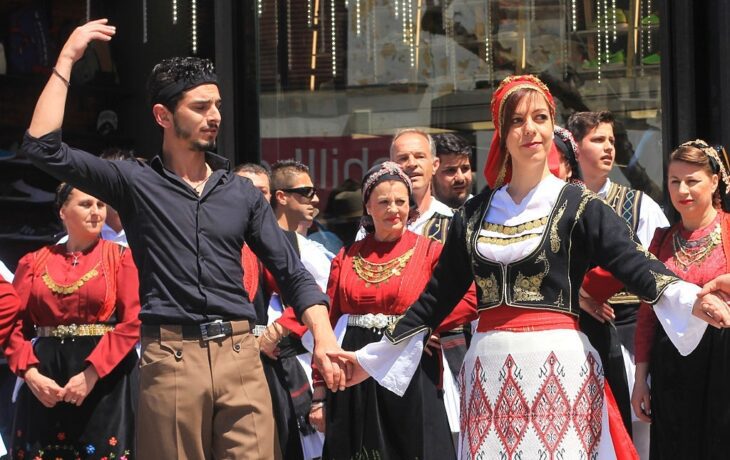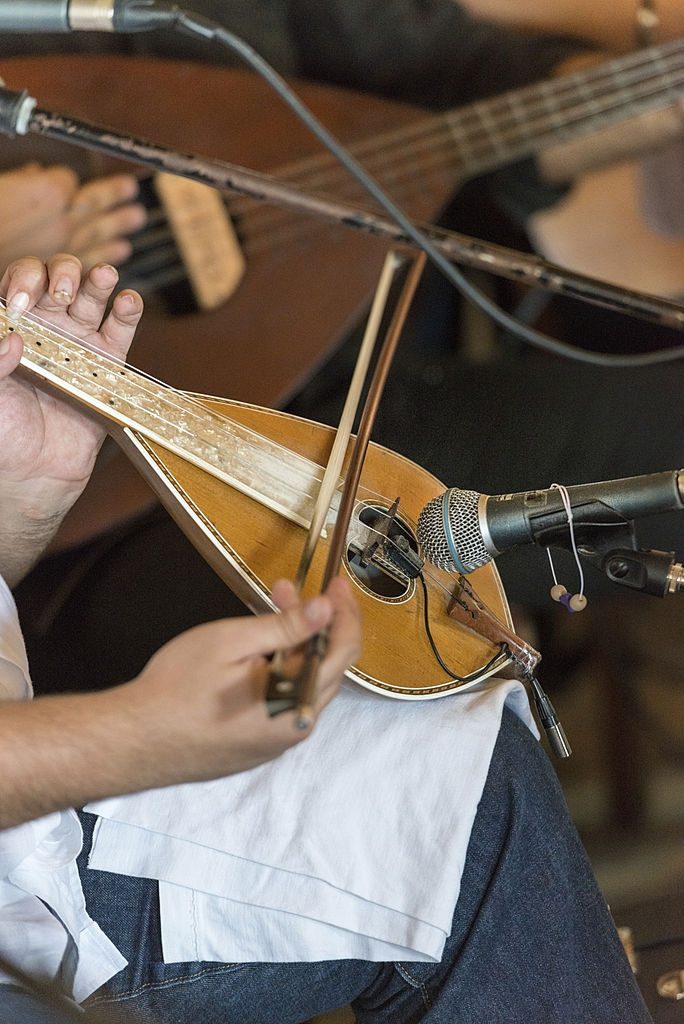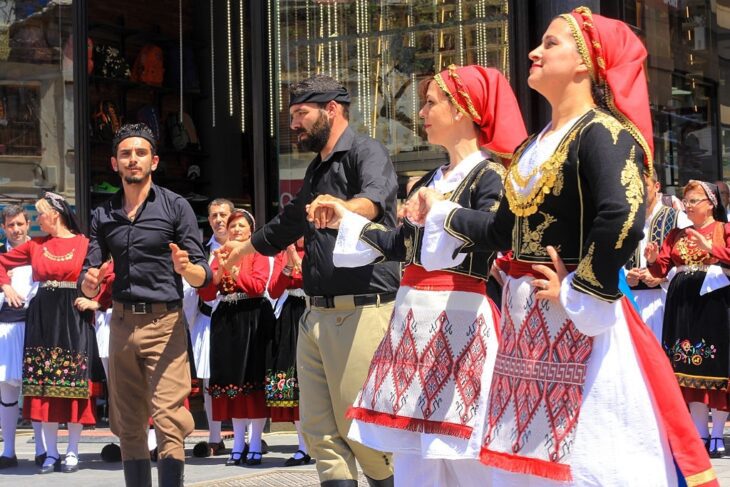Mantinades: All About the Famous Rhyming Couplet of Crete

One of the many wonderful things about Crete is that traditional culture plays such an important role in contemporary life, and among all age groups. Tradition is embraced by all generations and is seamlessly and beautifully integrated into Cretan daily life. One of the signature features of Cretan traditional culture is known to all throughout Greece – Mantinades.
What are Mantinades?
Mantinades are rhyming couplets with a rhythmic pattern, typically used in improvisation to express various emotions and experiences. Unlike limericks, which have five short lines and a playful tone, mantinades consist of two longer lines and convey a broader range of sentiments. Their clever construction requires skill, making them both artistic and expressive.
Mantinades express every aspect of human experience, contrasting with the often bawdy Limericks. Creating Mantinades is an acquired skill, with some crafting clever verses for any occasion or emotion.

The Form of Mantinades – the Rhyming Couplet
Mantinades are rhyming couplets, each comprising two lines of fifteen syllables, known as dekapentasyllabic verse. This poetic form emphasizes symmetry and rhythm, deeply rooted in Cretan oral traditions. The structured syllabic count and rhyming pattern enhance its lyrical quality, allowing for emotional expression and cultural storytelling.
What is the Dekapentasyllabic Verse?
Dekapentasyllabic verse is a fifteen-syllable poetic meter widely used in the Byzantine period. It is also called “Political” verse, where “political” derives from “polis”, meaning city, signifying secular poetry focused on daily life. This form became prominent in popular and folk traditions, emphasizing non-religious themes. Political, in this context, derives from “polis”, meaning city, and refers to secular poetry rather than religious themes.
What is Iambic Verse in Mantinades?
In mantinades, iambic verse refers to the rhythmic structure where each line typically follows a pattern of alternating syllables, with a short, unstressed syllable followed by a longer, stressed syllable. This iambic rhythm enhances the lyrical and melodic quality of the couplets, which are central to mantinades’ expressive form.

What is the history of Mantinada?
Mantinades were popular originally in the Byzantine Era – in Crete, this means the era of the Venetian Occupation (1205 – 1669). This means that, while much of Greece was in the control of the Ottoman Empire, beginning from 1430 in some areas, even before the fall of Constantinople, Crete remained Christian under the Venetians. This was a period of cultural flourishing, sometimes called the “Cretan Renaissance”. Mantinades were a key form of cultural expression in this era, and remain so today.
Where Does the Word Mantinades Come From?
The word “Mantinades” originates from two potential sources. One ties it to the Greek verb “mantevo”, meaning “to divine”, reflecting ancient poetic prophecies. The other links it to the Italian “mattino” (dawn) or “Mattinata” (morning), influenced by Venetian rule over Crete, where Mantinades emerged.
Is the Mantinada a Musical Poem?

The Mantinada is a rhyming couplet. It is not a song lyric, however, in itself, it has such a strong and clear rhythmic quality, and a lilting cadence that feels musical. Moreover, Mantinades are very well-suited to accompaniment of music, the Cretan lyra especially, as well as the “laouto” – stringed instrument like a lute. In practice, it is very common for a Mantinada to be delivered as a song.
Read more about the Famous Cretans: Artists, Chefs, Musicians and Scientists.
What are Mantinades About?
Mantinades are poetic verses central to Cretan culture, reflecting life’s events with depth and emotion. They convey truths, commemorate the deceased, and often appear on tombs. Mantinades reflect wit and wisdom, blend humor with insights, and express Cretan life and traditions.
The Mantinada demonstrates wit and wisdom, combines humor with substance, and highlights love as a favorite subject central to life.
“Κάθε λεπτό σε σκέφτομαι κάθε στιγμή μου λείπεις, υπάρχεις μες στο αίμα μου σαν τον ιό της γρίπης!”
“Kathe lepto se skeftomai, kathe stigmi mou leipeis, Iparcheis mes sto aima mou san ton io tis gripis”
“I think of you each moment, ever I miss you, it’s true, You run in my blood like a virus, like some kind of flu.”

And the inspiration of others is Crete itself:
“Όσο υπάρχουν τα βουνά και στέκει ο Ψηλορείτης, δεν έχουν φόβο να χαθούν τα έθιμα της Κρήτης”.
“Oso yparchoun ta vouna kai steki o Psiloritis, then exoun fovo na hathoun ta ethima tis Kritis.”
“As long as there are snowy peaks, and proudly stands Mt. Psiloriti, There is no fear that we will lose the precious customs of Kriti”
Who Creates and Performs Mantinades?
Cretans create and perform mantinades, with individuals of varying skill levels contributing to this tradition. These spontaneous poetic expressions often emerge in social gatherings, reflecting the Cretan lifestyle. Their antiphonal nature supports lively dialogue, enabling participants to exchange verses in a manner similar to a lyrical contest rooted in Byzantine culture.
The Cretan lifestyle fosters this art, often sparking spontaneous performances during social moments, such as after meals with raki. Mantinades often adopt an antiphonal form, inviting responses, resembling a southern Mediterranean rap battle rooted in Byzantine tradition.
Mantinades adopt an antiphonal form, suiting them to dialogue. One Mantinada invites another in response, enabling friends to engage in skilful banter resembling a southern Mediterranean rap battle rooted in Byzantine tradition.

What are the Mantinada Contests?
Mantinada contests are competitive events in Crete celebrating the traditional art of mantinada. Participants, called mantinadomachos, rapidly exchange mantinades, adhering to themes and improvising responses. Events are hosted by Cretan municipalities, cultural associations, and media platforms, preserving this art form while engaging modern audiences through radio, newspapers, and themed competitions.
Major Mantinada contests are organized by the Municipalities of Agios Nikolaos and Ierapetra, the Philologists’ Association of Chania Prefecture, the Cretan Students’ Union of Athens, and the “Michalis Kafkalas” Cretan Rhymers’ Association.
What is the most famous Mantinada?
The most famous mantinada is from “Erotokritos”, written by Vitzentsos Kornaros, a prominent Cretan poet of the late Renaissance, in the early 17th century. This epic poem, celebrated in Crete and across Greece, features over 10,000 rhymed dekapentasyllabic verses, embodying the rich oral tradition and cultural heritage of mantinades.
Mantinades represent an important cultural treasure of Greece. Recognizing their rhythms helps identify them throughout a journey.
Last updated on January 5th, 2025












